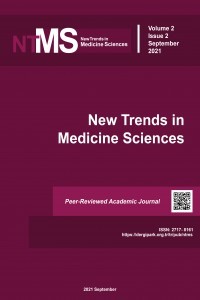Evaluation of 0-2 Month Old Infants Brought to the Pediatric Outpatient Clinic for Restlessness
Evaluation of 0-2 Month Old Infants Brought to the Pediatric Outpatient Clinic for Restlessness
restlessness, hypercalsiuri urinary tract infection, baby,
___
- 1. Hiscock H. The crying baby. Australian Family Physician Vol. 2006;35: 680-684
- 2.Karabel M, Karabel D, Tayman C, Tonbul A, Tatli MM. Evaluation of Risk Factors and Pharmacological Treatment Approaches in Infantile Colic Turkish J. Pediatr. Dis. 2010; 4(1): 12-17
- 3. Wessel MA, Cobb JC, Jackson EB, Harrıs GS Jr, Detwiler AC. Paroxysmal fussing in infancy, sometimes called colic. Pediatrics. 1954 Nov;14(5):421-35.
- 4. Neu M1, Robinson J. Infants with colic: their childhood characteristics. J Pediatr Nurs. 2003 Feb;18(1):12-20.
- 5. Milliner DS. Urolithiasis. In: Avner ED, Harmon WE, Niaudet P, (eds). Pediatric Nephrology. Philadelphia: Lippincott Williams&Wilkins, 2004: 1094-5.
- 6. Donmez O, Yuce N, Ilcol YO, Ediz B, Durmaz O, Kilicbay I. Urinary calcium excretion in healthy children. Turkish Ped Arc 2009; 44: 131-4
- 7. Stanley FL. Reference Intervals for Laboratory Tests and Procedures. In: Kliegman RM, Stanton BF, Schor NF, Geme JW, Behrman RE (eds). Nelson Text Book of Pediatrics. United States of America, Elsevier Saunders, 2011; 19
- 8. Orhon FS. Current Approaches in Diagnosis and Treatment of Infantile Colic. Ankara University Faculty of Medicine Journal 2016, 69 (3).
- 9. Freedman SB, Al-Harthy N, Thull-Freedman J. The crying infant:Diagnosis testing and frequency of serious underlying disease. Pediatrics 2009;123:841-848.
- 10. Turkmen M, Ozkan P, Aydogdu SA. Comparison of urine culture results obtained with bag and suprapubic aspiration method in newborns. Journal of Child Health and Diseases 2008; 51: 193-198.
- 11. Kanellopoulos TA, Salakos C, Spiliopoulou I, et al. First urinary tract infection in neonates, infants and young children: a comparative study. Pediatr Nephrol 2006; 21: 1131-1137.
- 12. Gorgen O. An Overview: Childhood Urinary Tract Infection. Journal of Nephrology Nursing 2016 July - December 2. Issue50-64.
- 13. Gurgoze MK, Dogan Y, Kizirgil A, Toraman Z, Aygun D, Susceptibility of bacteria isolated from children with urinary tract infection to various antibiotics, Firat Medical Journal 2002; 7: 828-832. 14. Cetin H, Oktem F, Ormeci AR, Yorgancigil B, Yayli G, Escherichia coli and antibiotic resistance in childhood urinary tract infections, Suleyman Demirel University Journal of Medicine 2006; 13: 12-16.
- 15. Yasar KK, Pehlivanoglu F, Şengoz G, Distribution of gram negative microorganisms and antibiotic resistance in urinary tract infections in pediatric age group, Zeynep Kamil Medical Bulletin 2010; 41: 137-41. 16. VanDervoot K, Wiesen J, Frank R, et al. Urolithiasis in pediatric patients: a single center study of incidence, clinical presentation and outcome. J Urol 2007; 177: 2300-5
- 17. Melek E, Gulleroglu KS, Bayrakci US, Aygun C, Baskin E. Clinical and Metabolic Characteristics of Pediatric Patients with Urinary Stone. Turkey Children's Hospital Journal/Turkish J Pediatr Dis. 2016; 1: 40-45
- 18. Baysal YE, Koyun M, Akman S, Guven AG, Guntekin E. Urolithiasis in children: 10 years of experience in Antalya. Journal of Children's Health and Diseases 2004; 47: 254-9.
- 19. Altincik A. Relationship Between Urinary Tract Infection and Idiopathic Hypercalciuria in Children. Adnan Menderes University, Faculty of Medicine, Department of Pediatrics. Speciality Thesis. Aydin -2008
- 20. Sonmez F, Akcanal B, Altincik A, Yenisey C. Urinary calcium excretion in healthy Turkish children. Int Urol Nephrol 2007; 39: 917–922
- 21. Bastuğ F. Urinary Stone Disease in Infants: Etiology and Treatment. Bulletin of Endourology 2013; 6: 143-151.
- 22. Alpay H, Gokce I, Ozen A, Biyikli N. Urinary stone disease in the first year of life: is it dangerous? Pediatr Surg Int 29:311–316; 2013
- 23. Erol I, Buyan N, Ozkaya O, Sahin F, Beyazova U, Soylemezoglu O. Reference values for urinary calcium, sodium and potassium in healthy newborns, infants and children. The Turkish Journal of Pediatrics 2009; 51: 6-13
- 24. Vachvanichsanong P, Malagon M, Moore ES. Urinary tract infection in children associated with idiopathic hypercalciuria. Scand J Urol Nephrol,35:112-116,2001
- 25. MH Alemzadeh-Ansari Valavi E, Ahmadzadeh A. Predisposing Factors for Infantile Urinary Calculus in South- West of Iran. Iranian Journal of Kidney Diseases 2014;8:53-7.
- 26.Bilge I, Yilmaz A, Kayiran SM et al. Clinical importance of renal calyceal microlithiasis in children. Pediatr Int 2013;55:731-6.
- 27. Dursun I, Poyrazoglu HM, Dusunsel R et al. Pediatric urolithiasis: an 8-year experience of single centre. Int Urol Nephrol 2008;40(1):3-9.
- 28. Langman CB. Disorders of phosphorus, calcium, and vitamin D. In:Avner ED, Harmon WE, Niaudet P (eds) Pediatric Nephrology, 5th edition, Philadelphia, Lipincott Williams & Wilkins. 2004:237-255.
- ISSN: 2717-8161
- Başlangıç: 2020
- Yayıncı: Fazile Nur Ekinci Akdemir
Effect of Curcumin on Testis in Mice with Ehrlich Ascites Tumor
Seher YİLMAZ, Yeşim GÖÇMEN, Adem TOKPINAR, Şükrü ATEŞ, Mustafa NİSARİ, Aysen CANİKLİOĞLU, Ünal ÖZTEKİN
Evaluation of 0-2 Month Old Infants Brought to the Pediatric Outpatient Clinic for Restlessness
The Effect of Apilarnil on The Autophagia Against Lipolysaccarite-Based Sepsıs in Liver
Züleyha DOĞANYİĞİT, Betül KÖKLÜ, Arda UNER, Aslı OKAN, Emin KAYMAK, Sibel SİLİCİ
Ahmet YARDIM, Ramazan PAŞAHAN, Mustafa Namık ÖZTANIR, Osman ÇİFTÇİ, Aslı ÇETİN, Mehmet Arif ALADAĞ, Mehmet Akif DURAK
The Role of Chlorogenic Acid in Alleviating Intestinal Ischemia/Reperfusion-Induced Lung Injury
Ayhan TANYELİ, Derya GÜZEL, Fazile Nur EKİNCİ AKDEMİR, Ersen ERASLAN, Mustafa Can GÜLER
Ethnomedicianal Profile of Flora of District Sialkot, Punjab, Pakistan.
Fozia NOREEN, Mishal CHOUDRİ, Shazia NOUREEN, Muhammad ADİL, Madeeha YAQOOB, Asma GHULAM MUSTAFA, Fızza CHEEMA, Faiza SAJJAD, Usman MUSHTAQ
